初心者のためのDjango入門
■第8話:ORM(Object-Relational Mapping)の威力
(最終更新日:2023.07.18)

(絵が小さい場合はスマホを横に)
「ORMって何が良いの?」
Webアプリケーションフレームワークを使い始めたばかりの頃は、ORMの利点がすぐに理解できない人も多いだろう。
実際、新しいルールを本当の意味で理解するには時間がかかる。直接データベースにアクセスできる生SQLを使う方が良いと感じることもあるだろう。
そんな方に向けて、今回はDjangoのORMを例に、ORMの魅力について説明したいと思う。
[目次]
1ORMのメリット
ORMを使う利点は、主に3点ある。
①SQL文を書くことなく、使用しているプログラミング言語(Python)だけでデータベースの操作ができる。
②非常に簡潔な命令で操作できる。
③Modelと連携するため、Modelやmigrationファイルにtableの型定義やキー制約などの記録が残せる。
①および②に関して、ORMを用いると、定型的なCRUD操作は非常に簡単に実行できることが分かるだろう。 指定したModelのClass(以下のClass1)に対して命令するだけである。 Updateの場合はデータを指定し、変更内容を挿入して、保存するという3段階のプロセスが必要だが、 それでもPython上で関数やライブラリを使ってSQLを操作するよりはるかに簡単である。 言葉で説明するよりも、以下のコードを見ていただく方が理解しやすいだろう。 短いコードで簡単に書けるというのは、ルールを知っている人なら、誰がやっても書きやすく、誰が見ても分かりやすいことを意味する。 チームでコーディングする際、このことは非常に重要になるので覚えておこう。
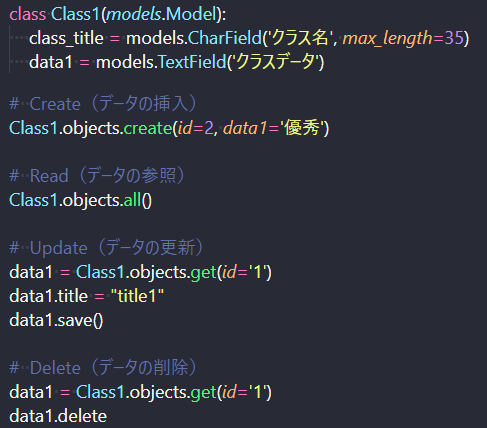
DjangoのORMによるCRUD操作
ちなみに、以下はORMを使用しない場合の操作で、上述のReadと同じ操作を行っている。 全件データを取得したいだけなのに、かなり手間がかかることが分かる。 さらに、Whereのような条件を指定する場合、SQLインジェクション対策のためにプレースホルダーを書く必要がある。 より長い命令になるということだ。 データベースの設定からセキュリティ対策まで、ORMは面倒な処理をすべて裏で行ってくれる。 これはかなり便利な機能で、その恩恵を受けて、ユーザーは簡潔に安全にコードを書くことができる。
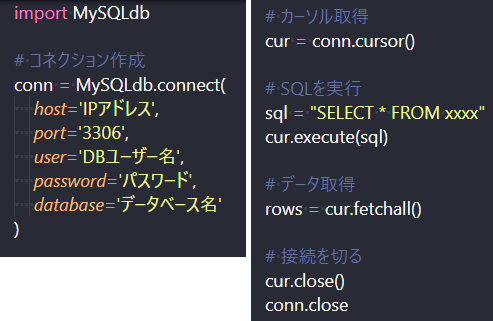
MySQLdbを使ったデータベース操作
③に関しては、以前書いたDjangoのModelに関する記事を見てほしい。 DjangoではModel作成からデータを取得するところまで、一貫して操作することができる。 履歴が残るので、どんなTable設計をしたかがDjangoのコードを見るだけで分かるだろう。
2.ORMの威力
ORMの強みは、特にデータ取得の際に発揮される。
データ取得方法として「objects.all」のほかに「objects.get」と「objects.filter」が利用できる。
「objects.get」は、取得データが1つの場合に使用する。それ以外の場合は「objects.filter」を用いる。
このような簡単な命令で、目的のデータを取得できる。
また、これらの返り値の違いを説明しておこう。
「objects.get」ではオブジェクトそのものを取得し、「objects.filter」ではQuerySetを取得している。
そのため、filterの場合はfor文で展開して値を取得する必要がある。
しかし、どちらの方法でも、簡単な命令でデータを取得できる。大きな利点である。
また、firstやlastといった、最初や最後のデータのみを取得する便利な命令も用意されている。ぜひそちらも試してみよう。
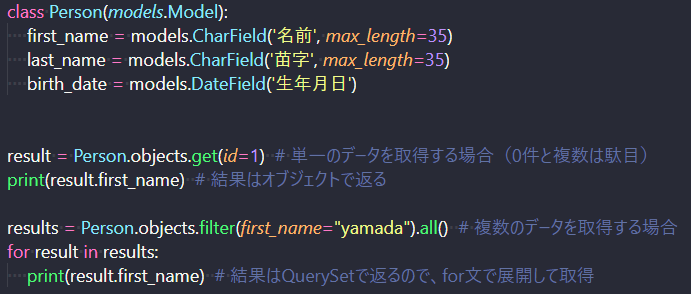
DjangoのORM、getとfilterによるデータ取得
さらに、Djangoの機能としてForeign Keyの指定が非常に便利である。 通常、入力に関する選択肢は対象のTableデータから参照する必要があるが、DjangoではForeign Keyを指定するだけで、その処理を自動で行ってくれる。 加えて、親Tableデータ(この場合はSubject)が削除された場合、CASCADEを有効にしていれば、関連するデータも自動で削除される。 これにより、データを管理する手間が大幅に軽減される。
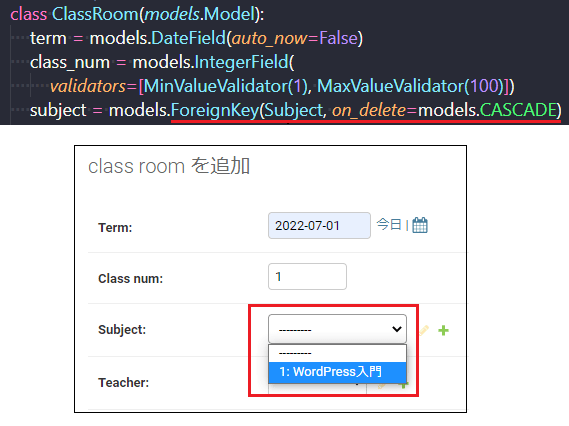
DjangoのForeign Key設定、選択肢をSubjectテーブルから取得してくれる
3.素のSQLを使いたいときは
これまで説明した命令は、ORMで実行できる。もちろん、1対1、1対多、多対多のリレーションなどにも対応できる。
しかし、複雑な命令や参照(検索)のパフォーマンスが必要な場合は、素のSQLで操作することが求められることもある。
Djangoでは、そのような場合にobjects.rawという命令を利用できる。
SQLを書く部分はrawの括弧内だけに限定されるため、冗長な記述を避けられ、命令の実行が可能になる。
ただし、Where句などで検索条件を指定する場合は、プレースホルダーを用いた書き方が必要である。
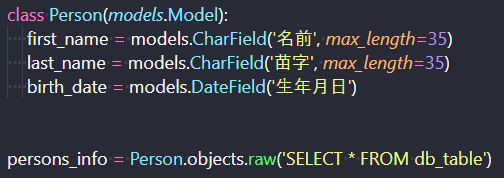
Djangoで素のSQLを使う操作
DjangoのORMは保守性からセキュリティ対策まで考慮されており、ORMで実現可能な命令は、極力ORMを利用することが推奨される。
4.まとめ
今回、ORMの威力について説明した。ORMが活躍するのはDjangoだけでなく、他のWebアプリケーションフレームワークでも同様である。 今回の説明で、素のSQLで実装する場合と比べ、どれだけ簡単に、安全にコードを書けるかを感じていただければ幸いである。
▼参考図書、サイト
Django パーフェクトマスター Udemy(小野宏司)
DjangoのModel.objects.filterの使い方【QuerySet】 ユーニックス総合研究所 | なるぽのブログ